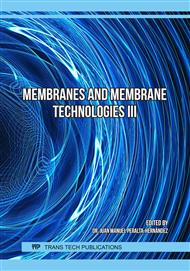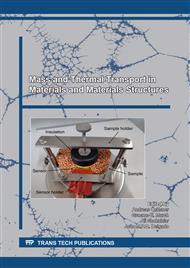[1]
A. Fakhru'l-Razi, A. Pendashteh, L. C. Abdullah, D. R. A. Biak, S. S. Madaeni, & Z. Z. Abidin, Review of technologies for oil and gas produced water treatment. J. Hazardous Mater. 170 (2009) 530-551.
DOI: 10.1016/j.jhazmat.2009.05.044
Google Scholar
[2]
E. T. Igunnu, and G. Z. Chen, Produced water treatment technologies. Int. J. Low-Carbon Technol. 9 (2014) 157-177.
Google Scholar
[3]
S. Jiménez, M. M. Micó, M. Arnaldos, F. Medina, and S. Contreras. State of the art of produced water treatment. Chemosphere 192 (2018) 186-208.
DOI: 10.1016/j.chemosphere.2017.10.139
Google Scholar
[4]
M. Padaki, R. S. Murali, M. S. Abdullah, N. Misdan, A. Moslehyani, M. A. Kassim, N. Hilal, and A. F. Ismail. Membrane technology enhancement in oil–water separation. A review. Desalination 357 (2015) 197-207.
DOI: 10.1016/j.desal.2014.11.023
Google Scholar
[5]
A. Abdullah, D. Johnson, and N. Hilal. Investigations of the effect of pore size of ceramic membranes on the pilot-scale removal of oil from oil-water emulsion. J. Water Proc. Eng. 31 (2019) 100868.
DOI: 10.1016/j.jwpe.2019.100868
Google Scholar
[6]
M. Z. Hu, B. L. Bischoff, M. E. Morales-Rodriguez, K. A. Gray, and B. H. Davison. Superhydrophobic or hydrophilic porous metallic/ceramic tubular membranes for continuous separations of biodiesel–water W/O and O/W emulsions. Ind. Eng. Chem. Res. 58(2) (2019) 1114-1122.
DOI: 10.1021/acs.iecr.8b04888
Google Scholar
[7]
D. M. Warsinger, S. Chakraborty, E. W. Tow, M. H. Plumlee, C. Bellona, S. Loutatidou, L. Karimi, A review of polymeric membranes and processes for potable water reuse." Prog. polymer Sci. 81 (2018) 209-237.
DOI: 10.1016/j.progpolymsci.2018.01.004
Google Scholar
[8]
Z. Jian-er, Q. Chang, Y. Wang, J. Wang, and G. Meng, Separation of stable oil–water emulsion by the hydrophilic nano-sized ZrO2 modified Al2O3 microfiltration membrane. Separation Purification Technol. 75 (2010) 243-248.
DOI: 10.1016/j.seppur.2010.08.008
Google Scholar
[9]
C. Xianfu, D. Zou, Y. Lin, W. Zhang, M. Qiu, and Y. Fan, Enhanced performance arising from low-temperature preparation of α-alumina membranes via titania doping assisted sol-gel method. J. Membrane Sci. 559 (2018) 19-27.
DOI: 10.1016/j.memsci.2018.04.032
Google Scholar
[10]
A. K. Fard, A. Bukenhoudt, M. Jacobs, G. McKay, and M. A. Atieh, Novel hybrid ceramic/carbon membrane for oil removal. J. Membrane Sci. 559 (2018) 42-53.
DOI: 10.1016/j.memsci.2018.05.003
Google Scholar
[11]
S. Saeed, M. Pishnamazi, M. Rezakazemi, A. Nouri, M. Jafari, S. Noroozi, and A. Marjani. Implementation of the finite element method for simulation of mass transfer in membrane contactors. Chem. Eng. Technol. 35 (2012) 1077-1084.
DOI: 10.1002/ceat.201100397
Google Scholar
[12]
H. L. F. Magalhães, A. G. B. de Lima, S. R. de Farias Neto, H. G. Alves, and J. S. de Souza. Produced water treatment by ceramic membrane: A numerical investigation by computational fluid dynamics. Adv. Mech. Eng. 9 (2017) 1-20.
DOI: 10.1177/1687814016688642
Google Scholar
[13]
A. Mohammad, and M. Rezakazemi. Computational fluid dynamics simulation of moving-bed nanocatalytic cracking process for the lightening of heavy crude oil. J. Porous Media 21 (2018) 539-553.
DOI: 10.1615/jpormedia.v21.i6.40
Google Scholar
[14]
ANSYS Fluent Theory Guide 15.0. ANSYS, Canonsburg, PA 33 (2013).
Google Scholar
[15]
F. R. Menter, Two-equation eddy-viscosity turbulence models for engineering applications. AIAA J. 32 (1994) 1598-1605.
DOI: 10.2514/3.12149
Google Scholar
[16]
D. C. Wilcox, Turbulence modeling for CFD. Vol. 2. La Canada, CA: DCW industries, (1998).
Google Scholar
[17]
B. E. Launder, and B. S. Dudley, Mathematical models of turbulence. No. BOOK. Academic press, (1972).
Google Scholar
[18]
ANSYS CFX 15, Solver Theory Guide, ANSYS, Canonsburg, PA 33 (2015).
Google Scholar
[19]
A. L. Cunha, Treatment of effluents from the oil industry via ceramic membranes - modeling and simulation. Doctoral Thesis in Process Engineering, Federal University of Campina Grande, Campina Grande, Paraiba, Brazil, (2014) 201p. (In Portuguese).
DOI: 10.21475/ajcs.2016.10.10.p7455
Google Scholar




